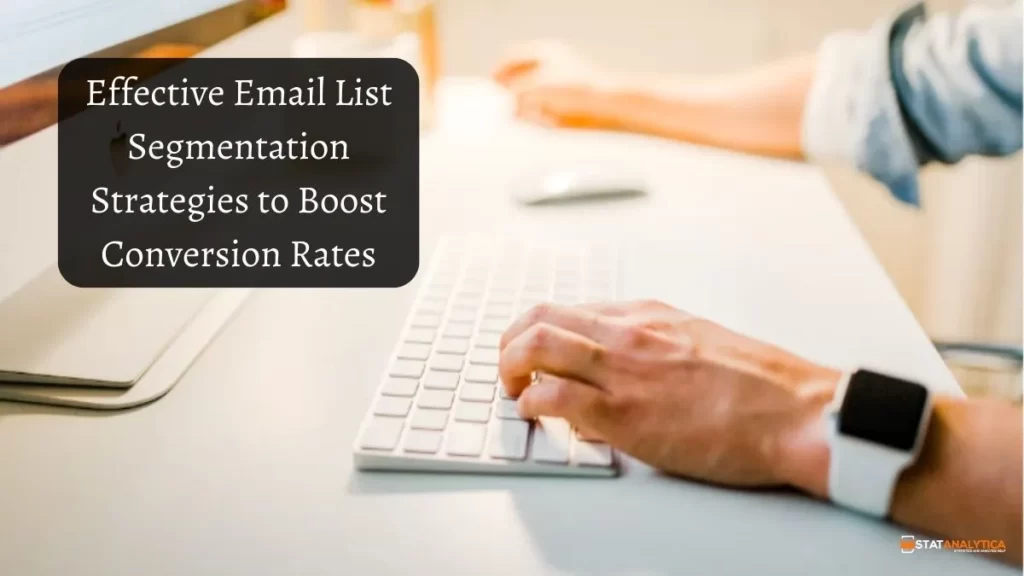Email marketing is an essential tool for businesses of all sizes. However, sending mass emails to the entire subscriber list could be ineffective. It could even result in a low conversion rate. That’s where email list segmentation comes into play. You can significantly increase your conversion rates by classifying mailing lists and sending targeted messages to specific groups of subscribers. In this article, we will discuss five effective email list segmentation strategies that anyone is able to use to boost conversion rates.
6 Email List Segmentation Strategies
Demographic segmentation
Is a powerful tool that allows businesses to tailor marketing campaigns to specific groups of customers. By dividing the mailing list based on characteristics such as age, gender, income, and location, you are able to send more relevant messages to each group’s needs and interests. For instance, a company that sells women’s clothing can classify its prospects by age range or income bracket and send targeted messages to users in each group. By doing so, they are able to showcase products that appeal to each group’s unique tastes and preferences, increasing the chances of converting subscribers into paying customers.
Behavioral segmentation
It helps identify subscribers who may need a little extra nudge to convert. For example, you could create a group of clients who have opened multiple emails but haven’t yet made a purchase. You could then send targeted messages to this group with incentives to purchase, such as a limited-time discount code. In addition, ensuring DMARC policy compliance is crucial when sending these targeted email messages, as it helps maintain email deliverability and security.
Another effective strategy is to divide prospects based on their level of engagement. For example, creating a segment of highly engaged subscribers who frequently open emails and interact with brands is also a good idea. You could then send them exclusive content, special offers, or early access to new products to reward their loyalty and encourage them to continue engaging with your brand. Utilizing Salesforge, a robust email sending platform, can streamline this process and help you effectively manage segmented email campaigns to maximize engagement and loyalty.
Psychographic segmentation
Understanding customers’ personality traits, interests, values, and other psychographic factors, that tailors messages to resonate with them on a deeper level. It helps build a loyal following and increases the effectiveness of the campaigns. Implementing psychographic segmentation, start by analyzing your prospects’ behavior and engagement patterns. You could also gather additional data through surveys, and quizzes that help understand their values, beliefs, and interests. This data can then be used in creating groups based on shared psychographic factors.
Time-based segmentation
By dividing potential prospects based on when subscribers joined your list or last interacted with a brand, you are able to send targeted messages at specific intervals for keeping your brand top of mind. It helps in increasing the chances of converting subscribers into customers. For example, if you run a pet products company, then sending targeted messages to customers who haven’t made a purchase in the last six months can be used.
These messages could include promotions, new product announcements, or other incentives encouraging them to make a purchase. By keeping these customers engaged with your brand, you are able to increase the chances of them becoming repeat customers. Implementing time-based segmentation, you’ll need to track user activity and organize the list accordingly. It could be done using marketing automation software that offers both automation and segmentation features. Once you’ve organized the list, automated campaigns that send targeted messages at specific intervals can be set up.
Cart abandonment segmentation
By reminding prospects of the items they left behind, you’re giving them a nudge of completing their purchase. You are able to also offer incentives such as discounts or free shipping to sweeten the deal and encourage them to convert. It is especially useful if the subscriber was hesitant to purchase because of the price. Implementing targeted website popup can effectively re-engage customers, prompting them to revisit their abandoned carts and potentially finalize their purchase.
Also, use cart abandonment classifying to gather feedback from clients about why they didn’t complete their purchase. This information helps you identify and address any issues with your website or checkout process that may be causing customers to abandon their carts.
Social media segmentation
For example, if a company runs a clothing brand with a strong Instagram following, you could organize the email list based on the customers who follow your brand on Instagram. You could then send targeted messages to this group, highlighting products that have been popular on your Instagram page, sharing behind-the-scenes content from your Instagram stories, or offering exclusive discounts to Instagram followers.
By sending messages that align with users’ interests and behaviors on social media, you can increase the chances of converting them into customers and building a stronger relationship with them. Additionally, social media market segmentation can help you to better understand your audience and their preferences, allowing you to optimize your social media strategy and overall marketing efforts.

Conclusion
Email list segmentation is a powerful tool for businesses to improve their marketing campaigns and boost conversion rates. By dividing mailing lists into targeted groups based on various criteria such as demographics, behavior, psychographics, time-based data, and cart abandonment, you are able to send personalized messages to prospects that are more likely to convert into customers.
Regularly reviewing and refining segmentation strategy ensuring that you are reaching the target audience and achieving marketing goals is also important. With the right approach, email list segmentation helps you build stronger relationships with your customers, increase engagement, and drive more sales for the business.


